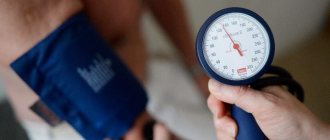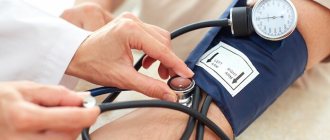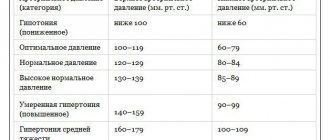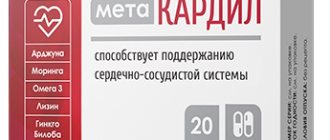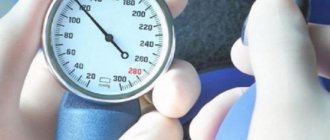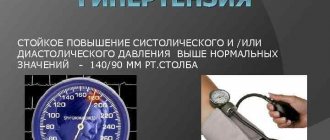Blood pressure indicators affect the general condition. The normal functioning of internal organs, but to a greater extent the activity of the cardiac and vascular system, depends on them. For this reason, it is important to closely monitor your blood pressure readings to help avoid adverse health problems.
For example, if the blood pressure monitor reads 130 to 70? Pressure at this level is normal or it is worth paying attention to this indicator, because it is considered a deviation from generally accepted standard norms. Sometimes these data do not pose a serious threat to health, but often they can indicate the development of certain diseases.
Meaning of indicators
According to the World Health Organization classification, normal systolic blood pressure ranges from 100 to 120, and diastolic blood pressure ranges from 60 to 80. Systolic, or upper, shows how tense the heart muscle is at the moment of pumping blood, while diastolic reflects the condition of the arteries when relaxing.
Deviation from the norm of the upper tonometer reading by more than 10 mm. rt. Art. indicates increased stress on the heart.
A blood pressure reading of 130/70 is called prehypertension. However, for some groups of the population it is the norm:
- aged people;
- adult men with a normal body mass index;
- athletes;
- hypertensive patients.
Prehypertension is considered a pathological condition for:
- pregnant women - this disrupts the blood circulation between the child and the mother, which can lead to gestosis, numbness of the limbs, and premature birth;
- hypotensive - the vascular systems of hypotensive patients adapt less well when pressure increases. This increases the risks of stroke and heart attack;
- children - the child’s developing body reacts heavily to hypertension;
- adolescents - prehypertension is typical for the puberty period, however, indicators at the level of 130/70 may indicate an increased risk of developing cardiovascular diseases.
Causes of high upper and low low blood pressure
Why does dissonance occur between the upper and lower blood pressure values? The state of the cardiac and vascular system is assessed by the level of systolic pressure. Its increase occurs with a heart rhythm disorder, congenital or acquired heart defects, as well as with excessive activity of adrenal hormones.
Diastolic pressure decreases as a result of loss of elasticity and tone of large arteries and the formation of cholesterol deposits on the walls of blood vessels.
Blood pressure 120 over 55 - what does this mean?
A simultaneous combination of increased upper and decreased lower pressure is observed in the presence of the following conditions:
- Aortic valve defects due to atherosclerotic disease.
- Excessive production of thyroid hormones.
- Old age, at which there is a decrease in arterial tone and cardiac dysfunction.
A large difference between the indicators can be observed with kidney dysfunction, which leads to excess production of renin, which affects the diameter of the vascular lumen. Excessive concentration of the hormone in the blood causes vasoconstriction, as a result of which the pressure may increase in systole and decrease in diastole. In this condition, the filtration capacity of the kidneys is impaired and the amount of urine produced decreases. A pronounced decrease in diastole, when the pressure is 130 to 50, can even lead to complete dysfunction of the paired organs.
The main causes of the pathological condition are associated with disruption of the cardiac and vascular system, namely:
- Suffered a stroke.
- Post-infarction state.
- Heart failure.
- Decreased elasticity of peripheral arteries.
- Stretching of the aortic walls and its branches.
Is this kind of blood pressure dangerous?
A blood pressure of 130/70 is called prehypertension, which means it is minimally above the upper limit of normal. If you do not change your lifestyle, then with such tonometer readings, there is a possibility of developing arterial hypertension. This significantly increases the risk of serious cardiovascular diseases such as heart attack, stroke, heart failure and dementia.
Prehypertension cannot be considered life-threatening. It serves as a signal to change your attitude towards your own health. Once you start exercising or change your diet towards healthier foods, the increase will disappear.
And also read on our website: Is pressure 100 over 70 normal? The meaning of indicators and pulse, why does the head hurt and what to do?
The danger arises in the presence of discomfort and various ailments, such as lethargy, numbness of the limbs or migraines. In this case, you should urgently consult a doctor, since such signs may indicate the development of pathological processes.
In pregnant women
During pregnancy, a woman is obliged to monitor her blood pressure, as this affects the body of the developing fetus. A blood pressure of 130/70 is considered the border between normal and pathological for women carrying a child, since the slightest manifestation of hypertension is regarded as gestosis and will require hospitalization. If a pregnant woman feels unwell and uncomfortable at 130/70, a doctor should be called immediately.
Possible complications of pathology
If the pressure of 130 to 60 is unstable, then no pronounced pathological changes occur. However, with long-term and constant detection of values, it is necessary to consult a therapist or cardiologist. The most common complications of a high pulse difference are:
- Increased risk of developing emergency cardiac pathologies and cerebrovascular accidents.
- Intensive decrease in the tone and elasticity of the arteries.
- Disorders of kidney and liver function.
- Dysregulation of the nervous system.
Causes
In men, especially older men, levels of 130/70 are considered normal if this condition is not accompanied by unpleasant symptoms. The causes of prehypertension in them are:
- smoking and drinking alcohol;
- stress;
- unhealthy diet:
- lack of physical activity;
- physical inactivity.
The most common causes of prehypertension in adolescents are:
- excess weight;
- stress and overwork;
- vegetative-vascular dystonia.
Common reasons for all population groups are:
- bad habits;
- disorders of the cardiovascular system;
- excessive consumption of sweet, fatty or salty foods;
- sleep disturbance.
Prehypertension is a transitional state between normal blood pressure levels and hypertension. Both conditions significantly increase the risk of developing cardiovascular pathologies.
Treatment
The necessary treatment will be prescribed depending on the cause that provoked the increase in blood pressure. To eliminate the symptoms of high blood pressure, the following can be used:
- antihypertensive drugs - the dosage will usually be minimal, since the increase in blood pressure is minimal;
- diuretics - diuretics help reduce blood pressure;
- beta-blockers are rarely prescribed; both selective and non-selective drugs can be used.
In some cases, medication adjustment of blood pressure may be required, although readings of 130/70 are not critical
The most common appointments are:
- Polythiazide;
- Dichlorothiazide;
- Spironolactone;
- Valsartan;
- Furosemide;
- Quinapril;
- Captopril;
- Irbesartan.
Following a diet is mandatory. It is necessary to completely exclude alcohol-containing drinks, coffee and drinks containing caffeine, fatty, smoked, highly salted dishes and products from the menu. The majority of the diet should consist of vegetables and fruits in any form, as well as foods rich in beneficial vitamins and microelements.
Folk remedies
What else can you do besides dieting and taking medications? Traditional recipes give good results:
- Plantain tincture. To prepare it you need to take 4 tablespoons of chopped herbs. Pour vodka (250 ml) into it and let it brew in a dark place for two weeks. Filter. Drink 30 drops three times a day.
- Lemon, cranberry, honey, rosehip. You need to thoroughly chop one lemon. Take 1 tablespoon of the product. Add to it the same volume of cranberries and chopped rose hips. Add 1 tablespoon of honey to the mixture and mix thoroughly. Eat 1 tablespoon of the mixture twice a day.
- Garlic infusion. Chop 2 garlic cloves and add boiled water (250 ml). Let stand for 12 hours. Filter the product and take the entire amount received in the morning. In the evening, prepare a new portion.
- Flax seeds. They must first be crushed in any convenient way, for example, in a blender or using a food processor. During the day you need to eat two to three tablespoons of the product. You can sprinkle crushed seeds on sandwiches or put them in salads and main courses.
Before you start using the chosen folk recipe, you must make sure that there are no contraindications.
Symptoms
Prehypertension is often asymptomatic, but the presence of the following ailments may indicate disturbances in the functioning of the cardiovascular system, which means it requires urgent medical attention:
- fainting;
- dizziness;
- blurry vision;
- apathy;
- nausea;
- loss of coordination.
A throbbing headache in the back of the head is a normal reaction of the body to high blood pressure and does not require radical measures, unless of course it is the only discomfort.
In cases where pain prevents you from concentrating on work or household chores, it is recommended to take a pain reliever.
Symptoms
A blood pressure level of 130 over 70 is not considered by doctors to be a pathological condition. But a certain group of people, due to the characteristics of the body, tolerate this small jump in blood pressure very poorly.
Typical symptoms of high blood pressure:
- attacks of nausea, sometimes ending in vomiting;
- active sweating;
- poor sleep, poor concentration;
- tachycardia;
- trembling of hands and feet;
- feeling of discomfort behind the sternum;
- headache;
- flickering of flies before the eyes.
Important! In some cases, loss of consciousness is possible.
If such symptoms develop, you should consult a doctor, as they indicate a dysfunction of the body. With timely diagnosis and timely treatment, the development of serious diseases can be avoided.
Pulse
Determining the pulse when measuring blood pressure makes it easier to determine the patient's condition. The average heart rate for a healthy person is between 60 and 80 beats per minute.
And also read on our website: What do blood pressure readings of 110 over 60 mean and for whom is this considered normal and what to do?
A rapid pulse against the background of prehypertension may indicate both physiological and pathological processes in the body, namely, excessive physical activity or the development of cardiovascular diseases.
A slow pulse along with prehypertension is more common in people with hypertension and taking antihypertensive drugs.
How to measure blood pressure correctly
You can purchase a blood pressure monitor today without any problems. Considering the low cost of such a device, it is advisable for all people who have cardiovascular pathologies or experience frequent changes in blood pressure to have it. There are mechanical and electrical tonometers, and each modification has its own advantages. Therefore, the right to choose remains with the buyer.
Measuring pressure readings does not take much time, but you need to prepare for the procedure correctly in order to obtain the most objective data.
To do this, in 30-120 minutes you cannot:
- drink,
- smoking,
- take any medications,
- eat,
- perform physically demanding types of work.
Immediately before the measurement, the bladder should be emptied.
During the procedure you need:
- relax,
- keep calm,
- sit straight,
- If possible, do not be distracted by conversations.
The device is attached to the arm, and the entire procedure is performed in strict sequence, as indicated in the instructions. If the results obtained differ from normal values, it is recommended to repeat the measurement after half an hour.
Good to know! To obtain the most reliable data, measurements are carried out for several days in a row on both hands. This approach allows you to track the dynamics of data changes and select the optimal treatment option, if necessary.
What to do?
Indicator 130/70 mmHg. Art. not always a deviation, but you should be wary if you find it on the tonometer monitor.
If nothing bothers you
If you do not experience any discomfort, a slight increase in blood pressure may be caused by stress, lack of sleep or excessive exercise. What this can fix:
- beet, carrot juice;
- motherwort tincture;
- tincture of valerian.
First aid if you feel unwell
- Reassure the patient; panic can significantly worsen his condition.
- Sit in a semi-lying position, provide fresh air in the room.
- Apply a cold compress to your forehead.
- Take a dose of diuretics if previously prescribed by your doctor. For chest pain, use nitroglycerin.
- Continue taking blood pressure measurements every 20 minutes.
If after these procedures the patient’s condition does not improve, call an ambulance.
What does pressure 140 to 80 mmHg mean? Art.?
Oxygen and nutrients enter our body through blood, which circulates through the vessels, exerting a certain pressure on them. Blood pressure manifests itself as a result of the process of compression of the walls of blood vessels. The unit in which it is measured is millimeters of mercury.
There are upper (systolic) and lower (diastolic) blood pressure. The indicator of upper blood pressure depends on the force and speed of the heart pushing blood into the vascular system. Lower - minimum pressure during the pause between compressions.
Blood pressure indicators depend on factors such as:
- the volume of blood that circulates in our body;
- vascular resistance to blood flow;
- an indicator of the strength of heart contractions.
Blood pressure can depend on both a person’s gender and age. However, the norm for most people is 120/80. Although each person’s blood pressure may be individual, deviations from this indicator are considered a cause for concern.
If your blood pressure is 140 over 80, what does that mean? A reading of 140 indicates that the upper systolic blood pressure is elevated. In the case when the upper pressure is 140 and the lower 80 is normal, the initial development of arterial hypertension is possible.
What to do if your blood pressure is 140 over 80 and your pulse is 80? First, let's decide on the question of what heart rate is considered normal for a person.
Normal heart rate for:
- teenagers - 55–95;
- people under 50 years old - 60–80;
- elderly people over 50 years old - 70–90.
Thus, we see that the pulse rate is not exceeded and it is necessary to treat the manifestations of hypertension directly. Based on this, in the case when the pressure is 140 to 80, while the pulse is 80 beats per minute, there is no serious cause for concern, except for directly increased blood pressure.
Blood pressure 140 over 85 is this normal? An increase in lower blood pressure can normally range from 60 to 85 mm Hg. Art. If your reading is 85 occasionally during the day, there is no cause for concern. But in case of chronic manifestation of the maximum indicator of lower blood pressure, especially in combination with increased systolic blood pressure, it is necessary to consult a doctor.
Is it normal?
It is impossible to say that 140 over 80 is normal pressure. Because even this, albeit not a very significant increase in blood pressure, is a sign of the manifestation of stage 1 hypertension.
With such pressure, many people do not notice a deterioration in their health or the appearance of any signs of illness. However, despite this, if you do not see a doctor and do not start treating the developing disease in time, it can progress and seriously affect the internal organs of a person.
The main symptoms of hypertension are:
- heartache;
- dizziness;
- nausea;
- pain in the back of the head;
- pulsation in the veins;
- clouding of consciousness;
- fear and feeling of anxiety.
In men
According to statistics, men are more susceptible to cardiovascular diseases than women. Risk factors for the stronger half of humanity are: heredity, smoking, age, obesity. The causes of hypertension in men are:
- heavy physical exertion on the body;
- poor nutrition;
- uncontrolled use of drugs;
- frequent use of alcohol and tobacco;
- a permissive attitude towards your body.
What to do with a blood pressure of 140 to 80 in men? Treatment and prevention of various indicators of high blood pressure, including 140/80 in men, is as follows:
- reducing salt intake;
- marinades, spices, spicy;
- reducing alcohol consumption;
- quitting tobacco;
- reducing physical activity;
- reducing stress levels.
In a teenager
The modern rhythm of life and the state of the environment are such that many diseases that were previously characteristic of older people are beginning to appear among young people. Blood pressure norms for adolescents are approximately the same as for adults: 100–140 per 70–90 mmHg. Art., pulse 60–80 beats.
The reasons for pressure 140 to 80 in a teenager can be:
- excessive physical activity;
- hormonal changes;
- poor nutrition;
- obesity;
- stress and emotional stress;
- heredity.
During pregnancy
Pressure of 140 over 80 during pregnancy can be caused by the fact that when women carry a fetus, the amount of circulating blood increases. In this case, the vessels can hardly bear such loads, and internal discomfort occurs.
Features of treatment for pregnant women include the need to constantly be under medical supervision to avoid a decrease in heart rate. Such patients are limited in the use of medications. You should not take alcohol tinctures so as not to harm the fetus. Doctors usually advise pregnant patients to:
- eat the fruits of viburnum and lingonberries;
- drink teas with lemon balm and mint.
However, this recommendation will be useful to all people who detect a pressure of 140 to 80 on a tonometer. What are the reasons and what to do in this case?
